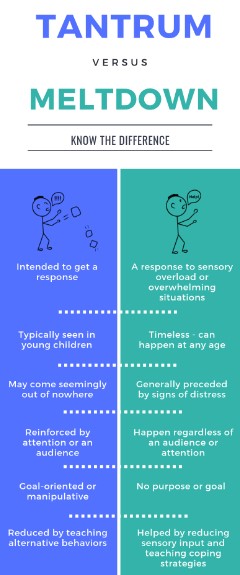Building Calm Classrooms: Proactive Tips for Managing Meltdowns In Your Classroom
26th July 2024

In a classroom, students might have to go through various situations in which they get overwhelmed and may have a meltdown. Many of the students might struggle to deal with strong emotions like-
- Fear
- Sadness
- Frustration
Or managing and accepting information with their senses. During a meltdown student might react in negative ways like- they might lash out, crying, or getting angry. During that time many teachers do not have a clue how to handle it. Also, most of the time, teachers also mix meltdowns with tantrums. However, there’s a huge difference between the two, and in the below image, you can see those differences.

However, those teachers who have pursued courses like Online Special Education Courses know how to identify meltdowns in students and also know how to handle those situations well.
If you also want to know effective ways of dealing with a child in a meltdown, then we have got you covered.
In this blog post, we will be sharing some of the helpful ways to tame tantrums and manage meltdowns of your children.
Before you move to the topic, can we ask you a quick question? Do you follow us on Social Media? If not, then you’re missing out on a lot of informative content. We regularly share upgraded educational content, tips, feedback, and more. Check us out by clicking the profiles here - Facebook / Twitter / LinkedIn / Pinterest / Instagram / YouTube
So, without any further delay, let’s get started.
What Are The Common Triggers of a Meltdown in Children?
Before preventing the meltdown in your children, you must need to understand some of the common triggers, which will help you to understand your children’s situation better. However, do remember that different triggers might occur within each student in the same situation. Let’s get to know some of the common triggers of meltdown in children:
Trigger From Basic Need
Whenever students feel angry, hungry, sick, or pain physically due to any reason they might have a hard time managing their emotions.
Sensory Overload
Some of the students might get overwhelmed with bright light, loud noises, different textures, touches, and tastes.
Sudden Change in Routines
Some students might get overwhelmed by any sudden or unexpected changes in their daily routines like- recess timing, assembly, timing, etc.
Frustration
Students might get overwhelmed with either too much of their academic work or due to conflict with their peers.
Traumatic Situation
Those students who are facing or have faced any traumatic situations might have had a hard time managing their emotions.
Learn, 6 Ways to Encourage Social Development In Children, here:
How To Identify Meltdown Triggers In Children?
Let’s get to know what triggers a student’s meltdown in a particular situation and how you can identify it.
- Have a genuine conversation with the student's parents to know what actions and behaviour they have observed in their home.
- If any students have IEP goals, then review them, and evaluate them. If you found any Functional Behavioural Assessment (FBA) is a part of IEP goals then check if you found any trigger or not.
- Ask student’s previous teachers whether they have shown any triggers or not in past.
- Have open conversations with students to understand their points of view, emotions, and thoughts.
- Observer every student, notice their day-to-day patterns, and also try to figure out how they react after the meltdown.
4 Effective Ways to Manage Meltdowns in Children
Let’s get to know some of the effective ways to manage meltdowns in children:
- To support your students better, you must use a neutral and calm tone of voice while interacting with them.
- Find a safe and comfortable spot where you can calm them down. It can be in a particular spot in the classroom or in a different room with a calm space away from other students' opinions and judgments.
- Don’t rush into offering strategies to manage meltdown situations, instead of giving them time and space first.
- Lastly, when the student is calm then try to figure out solutions together to deal with meltdown situations in the future.
Dealing With a Child In a Meltdown Has Become Easier
Knowing everything about the meltdown situation of your children is not an easy task. However, with the above-mentioned strategies of understanding, identifying, and dealing with a child in a meltdown, you can help your children deal with their overwhelming emotions, feelings, and thoughts better.
If you want to learn more effective and latest teaching strategies for supporting your special needs students. Then, consider pursuing courses like Online Special Education Courses, where you will get assistance from top expert trainers in the education industry.
We believe education should be accessible for everyone. That’s why we don’t charge for our blogs. Find the right course that will help you in your career with us, contact us at 91-6292150868. You can mail us at act@asiancollegeofteachers.com

